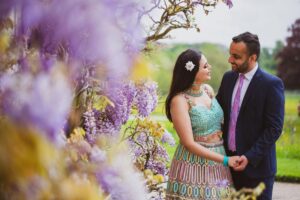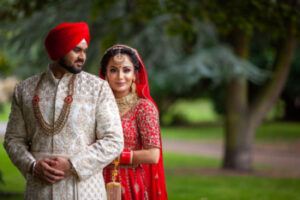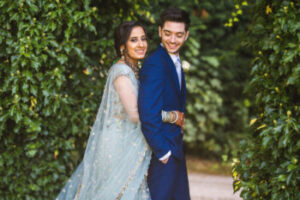SIkh Wedding terminology
Add Your Heading Welcome to our friendly guide, designed to help you navigate through the beautiful and rich traditions of a Sikh wedding, also known as an Anand Karaj ceremony. This guide will introduce you to the key terms and rituals you might encounter, enhancing your understanding and appreciation of this sacred occasion.Text Here
A
- Anand Karaj: The Sikh wedding ceremony, meaning “Blissful Union,” consists of the couple circumambulating the Guru Granth Sahib four times while marriage hymns are sung.
- Ardâs: A prayer offered to seek blessings from the Almighty before and after significant events, including the Anand Karaj.
C
- Chaur Sahib: A ceremonial fan used to show respect to the Guru Granth Sahib. It’s made from fine fibers, such as yak hair, and symbolizes reverence and service.
- Choora Ceremony: A ritual where the bride wears a set of special bangles, signifying her marital status and the blessings of her family.
- Chunni Ceremony: A pre-wedding event where the groom’s family presents a chunni (scarf) to the bride, symbolizing her acceptance into their family.
D
- Darbar Sahib: The main prayer hall in a Gurdwara where the Guru Granth Sahib is placed and Anand Karaj is conducted.
- Doli: The ceremonial departure of the bride from her parental home to her husband’s home, marking the conclusion of the wedding festivities.
G
- Gaaney: An auspicious red thread worn during the wedding, symbolizing protection and purity.
- Golak: The donation box placed in front of the Guru Granth Sahib, where devotees offer contributions as a sign of respect and support for the Gurdwara.
- Gurbani Kirtan: The singing of hymns from the Guru Granth Sahib, which plays a central role in the Sikh wedding ceremony.
- Gurdwara – The Sikh place of worship where the Anand Karaj is often conducted.
H
- Haar: Floral garlands exchanged between the bride and groom during the wedding ceremony, symbolizing their union.
- Hukamnama – A random verse from the Guru Granth Sahib read after the Anand Karaj, providing guidance for the couple’s married life.
J
- Jaggo: A pre-wedding celebration involving singing, dancing, and the carrying of a decorated pot with a lighted lamp, symbolizing the awakening of the family to the wedding event.
K
- Kalgi: A decorative plume or brooch worn by the groom on his turban, signifying nobility and honor.
- Kalire: Ornamental accessories tied to the bride’s choora (bangles), symbolizing happiness and prosperity.
- Kara: A steel bracelet worn by Sikhs as a reminder of their faith’s ideals; also, a decorative bangle worn during the wedding.
- Kirpan: A ceremonial sword carried by the groom, symbolizing dignity, honor, and the Sikh duty to stand against injustice.
- Kirtania Jatha: A group of musicians performing Gurbani Kirtan at the wedding.
L
- Langar – The community meal served to all guests at a Gurdwara after the wedding ceremony, emphasizing equality and community.
- Lavan: The four hymns sung during the Anand Karaj, outlining the stages of spiritual and marital life.
M
- A Maiyan Ceremony is a traditional pre-wedding ritual celebrated in Punjabi culture, marking the preparation and blessing of the bride or groom before their wedding day. Typically held at the family home, the ceremony involves applying a mixture of turmeric (haldi), sandalwood, and other ingredients to the individual’s skin by family and friends. This act symbolizes purification, good luck, and the radiant glow of happiness for the upcoming nuptials.
- Mehndi Ceremony: A pre-wedding ritual where henna is applied to the bride’s hands and feet, symbolizing beauty, joy, and spiritual awakening.
- Milni: A ceremony where families of the bride and groom meet and exchange garlands, symbolizing the uniting of two families.
N
Nam Karan – The Sikh naming ceremony, not directly related to weddings but an important ritual in Sikh culture.
P
- Palla: A scarf or piece of cloth used in the wedding ceremony, symbolizing the bride’s acceptance by the groom.
- Peeri: A low stool used during pre-wedding rituals like the Maiyan, symbolizing the bride and groom’s preparation for marriage.
- Paani Varna
- At the groom’s house, the Paani Varna ritual takes place to welcome the bride into her new marital home. The couple is greeted at the front door by the groom’s mother, who holds a garvi (a small earthen pot) filled with a mixture of half milk and half water.
- As a playful and symbolic gesture, the groom’s mother moves the garvi clockwise in front of the couple, pretending to take a sip of the mixture each time it passes her. The groom playfully keeps her from taking a sip until she tries for the seventh time. This light-hearted interaction adds joy and excitement to the ceremony.
- On the seventh attempt, the groom’s mother successfully takes a sip from the garvi, signifying the acceptance and blessings of the couple’s union. It symbolizes the mother’s willingness to embrace the bride as her own daughter and her approval of the marriage.
R
- Rangoli: Colorful patterns created on the ground, symbolizing joy and welcoming guests.
- Roti Ceremony: A ritual involving the preparation of bread, symbolizing the bride’s readiness to take on household responsibilities.
- Rumalla: A decorative cloth offered to the Guru Granth Sahib, symbolizing respect and devotion.
S
- Sach Khand: The highest spiritual state in Sikhism, symbolizing the ultimate union with the Divine.
- Sagan – A ceremony where the groom is given gifts by the bride’s family, often occurring after the engagement
- Sangeet/Gaana Ceremony: A musical evening prior to the wedding, celebrating the joy of the upcoming union through song and dance.
- Sewadar: A volunteer who serves in the Gurdwara, embodying the Sikh principle of selfless service.
- Sherwani: A long coat-like garment worn by the groom during the wedding, symbolizing elegance and formality.
- Shagun: Gifts or money given as a blessing, symbolizing good fortune and prosperity.
T
- Takhat: Literally meaning “throne,” it refers to the elevated platform where the Guru Granth Sahib is placed during the ceremony.
V
Vachan – The term for the marriage vows or promises made between the couple during the ceremony. These vows are taken in the presence of the Guru Granth Sahib, the Sikh holy scripture, emphasizing commitment, love, equality, and mutual respect.
Varna – Though not a common term in Sikh weddings, it traditionally refers to the broader concept of social order or class. In the context of Sikhism, all people are considered equal, reflecting the religion’s principles against caste discrimination.
W
Waheguru – A term used to refer to God or the Supreme Being in Sikhism. During Sikh weddings, prayers and hymns are sung in praise of Waheguru, seeking blessings for the couple’s future together.
Y
Yatra – A pilgrimage or procession. In the context of a Sikh wedding, it could refer to the procession of the groom’s party (Baraat) arriving at the bride’s home or the venue where the wedding ceremony (Anand Karaj) is to be conducted.
Z
Zaffa – While not traditionally part of Sikh weddings, the term refers to a wedding procession in Middle Eastern cultures. Sikh weddings have a similar concept with the Baraat, where the groom arrives with his family and friends in a procession to the wedding venue.





